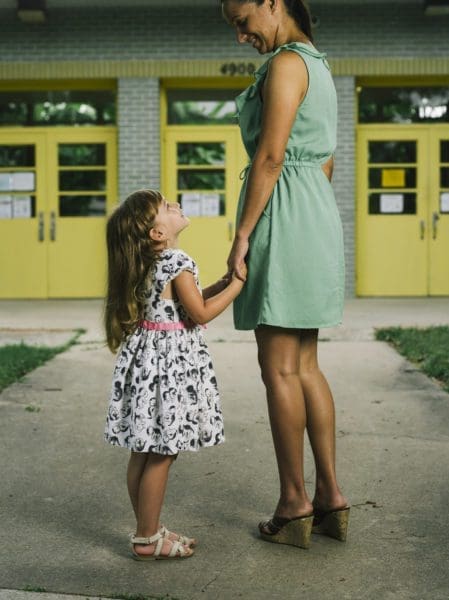Bridging the Gap in Education

In the Face of Change
Words by Camille Smith Photos by Eric Morales
When I moved to the east side in 1989, people still grimaced at the notion. We didn’t lock our doors, we knew our neighbors, and as kids, we played in the street until dark. Times have changed, as have the perceptions from within, and the east side today has a different connotation than it once did. When my eldest child became school age, I was excited by the prospect of sending her to the same schools I attended, where some of the same teachers taught, and the same custodians greeted me each morning as they did 25 years prior. Yet, this time there were differences I found worrisome. As a mother and a local, a desire was born to explore how the community’s changing demographics are effecting the children in their learning environments and how experience has shaped east Austin family’s involvement in our local public schools. How can we stay mindful of the many perspectives that affect our places of learning and create environments that are inviting and receptive to the chorus of concerned voices? As educators, parents, caregivers, and administrators, we share the role of advocate in the struggle to keep our public schools enriching places where all are welcome.
The Changing Face of East Side Schools
Maplewood Elementary is currently flourishing as one of Austin’s most diverse public schools despite their changing demographics and having their Title I funding cut. Rachel Robinson, retired pre-k teacher at Maplewood, recalls the days before funding was cut. “Maplewood used their Title 1 money to offer free classes after school, [such as] bird watching, knitting, soccer, skateboarding, and teachers were paid for their time.” Currently, Maplewood still offers after school activities, but they can be cost prohibitive to some families.
Under Texas’ “Robin Hood Plan,” a portion of property taxes are recaptured and then disbursed to less advantaged districts throughout Texas. This means even when money makes its way into impoverished neighborhoods, it doesn’t always end up in the community schools, leaving them struggling to work with a dwindling budget. Additionally, as families are priced out, local schools may lose their Title 1 funding, which is allotted to schools with a high percentage of economically disadvantaged students.
However, “Maplewood is an anomaly for the east side. Many families on the east side are transferring their kids out to different areas,” says Heather Salaz, an AISD teacher mentor who has spent 13 years in various Austin schools. It seems more and more families are choosing reputable schools over local ones by opting to transfer to higher-ranking public or private schools. “Enrollment numbers at Winn [Elementary] hover around 50%,” according to Andy Sams, recent east side transplant and mentor at Winn. “Ultimately this is an outward symptom of challenges at the school,” he adds. Many families are drawn in by the appeal of charter schools. “They sell a great product,” says Constanza Hill who has worked in east Austin schools for over 13 years. According to AISD, charter school transfers in the 2014-2015 school year accounted for about 25% of non-returning students; many families who leave name a lack of affordable housing as the reason.
“It can be done, but it will take very strategic, thoughtful outreach. Everyone needs to be validated for what they bring to the table, no matter how big or small.” -Rachel Robinson
“Most families, regardless of race and socioeconomic status in east Austin,… just want quality schools in their neighborhoods,” says AISD Board of Trustees member Kendall Pace. She adds that strong schools should be the first priority. “We should not wait until the neighborhoods are gentrified to have quality schools in every neighborhood, whether they are filled with students of one predominate race or a highly diverse campus.” Many east side schools have been working diligently to create and implement more enriching models for their students as they weather the many challenges under-funded and under-enrolled schools face. Blackshear Elementary is one such school. “We should look to replicate its success to other schools to meet the increasing demand for its excellent academic results and enrichment,” says Pace.
What’s Limiting Family Participation?
Andy Sams recently purchased a home in east Austin after renting there for several years. “When I moved to University Hills in early 2013, I immediately wanted to get involved in the community.” So Sams began to volunteer in the neighborhood elementary school as an Austin Partners in Education mentor. “I was surprised to hear that very few mentors volunteered at the school. I also began to observe practices throughout the school that concerned me.” His list of concerns include what he calls “a lack of community outreach, a non-functioning PTA, and little to no parent involvement” among others.
“We just have to put our guards down and [say] ‘I’m going to do the best I can, and I’m going to accept the fact that you are going to do the best you can.’ “-Rachel Robinson
Sams is one example of an east side transplant who is working towards positive change in his community school, but for many families, that kind of commitment just isn’t an option. “When it comes to being involved, attending meetings, helping with fundraising, doing things to make the school better, it gets tough. Our parents may be working 12 hour days…or night shifts. We may have single moms who are taking care of their children and other people’s children, or grandparents who have taken on the role of parents again,“ says Stacie Smith, parent and board member as well as librarian at Govalle Elementary. “What usually happens is the concerns of the parents who have more time, money, and a larger social network overshadow the concerns of the parents with less,” adds Candace Hunter, long time educator and east Austin parent. “The children with more involved parents have safety nets that the other children don’t have,” suggests Robinson, “and that’s the tragedy of it.”
Govalle Elementary opened its doors 85 years ago, and the same families have been attending for generations. “Govalle, like all U.S. schools, bears the historic burden of systemic racism and classicism,” says Smith. “We have parents and grandparents who experienced the institutional inequities present in nearly all U.S. schools serving primarily African American and Latino children. For some parents, Smith says, “school is not a place to be trusted, and the school has to work really hard to build relationships with those parents.” And for others, “School knows best. Schools have to understand their power, not take advantage of those parents and make sure they have all the information they need to advocate for their kids.” Then there are remaining families who seek to work in tandem with the school. These parents “want to get all the information they can to ensure their child gets the best education,” adds Smith. Each individual family has a unique relationship with institutions of learning, for which the reasons are varied and multi-faceted. “I would say the biggest difference between folks in higher income brackets and lower income brackets is access to information and knowledge of decision-making processes in schools,” Smith notes.
Fostering Growth & Creating Inclusion
School administrators are tasked with the delicate role of meeting the needs of diverse demographics and creating inclusive and culturally relevant environments. Additionally, parent organizations should be sensitive to the myriad reasons for historically low parent involvement and advocate for collaboration and communication from all families.
“We should look to replicate [Blackshear Elementary’s] success to other schools to
meet the increasing demand for its excellent academic results and enrichment.”
-Kendall Pace
“One thing I’ve learned is that having a strong administration at a school is vital to success,” says Sams. “The teachers and staff in east Austin, by default, have to work harder in order to serve their student base. A highly capable, innovative leader at a school, who can motivate and support their staff, is a critical requirement for success,” he says. When faced with an influx of families and their unique needs, the needs of the preexisting families cannot go ignored. “The ideal administrator would come in and say, ‘This is the culture of our school, we welcome you and we need to develop a relationship of trust, where I see that you value what we have and what we’ve been and understand the history and culture of this community and you become part of it, not that you’re going to come in and save it, not that you are somehow better.’ But to be able to develop trust… which comes from bold honesty,” says Robinson. Additionally, “having teachers who are trained in facilitating courageous conversations about race,” is invaluable says Pace.
Dusty Harshman, an east Austin parent and school volunteer and a previous Maplewood PTA president, is a firm believer in the positive effects that racial and economic integration can have on public education. However, he stresses the need for inclusion adding, “Even well-integrated schools can struggle with being inclusive.” Harshman thinks staff, teachers, and parent groups should mirror the diverse community they serve. “This often requires making intentional hiring choices, supporting culturally-relevant curriculum and recruiting diverse, parent leadership.” When it comes to welcoming people who have historically not participated in their public schools, educators and parent organizations have to work harder to encourage participation. Ursula Banks, former Maplewood PTA president and east side mom, suggests that PTA and other parent organizations remain mindful of the student body they serve. If the PTA doesn’t reflect the student body, they need to reassess if they’re doing enough. “Why aren’t more people coming out? It could be because they don’t feel welcome…” she suggests. “People need to be willing to step outside their comfort zone, to make an effort to reach out, to make connections,” Banks adds.
Studies show that children gain a multitude of benefits from family involvement like higher student achievement, better attitudes toward school, lower dropout rates, and countless more, regardless of socioeconomic status, race, or their family’s education level. Fostering participation from all families requires having not just casual conversations but uncomfortable ones. “Honest conversations that build trust between the individuals,” suggests Robinson. “It can be done, but it will take very strategic, thoughtful outreach. Everyone needs to be validated for what they bring to the table, no matter how big or small,” she adds.
“People need to be willing to step outside their comfort zone, to make an effort to reach out, to make connections.” -Ursula Banks
In Smith’s experience, she’s seen that “Many lower income parents are savvy and passionate; [they] advocate for kids at the Board of Trustees meetings and have access to different kinds of fundraising. We have low income parents who are on District-level committees, like the English Language Learners Parent Advisory Committee. We have a PTA that has won awards this year for increased membership… When you have people of different races and income brackets, there can be tension…but the way to handle that is to be intentional and explicit about how we will treat each other, and that all ideas, contributions, and experiences are valuable. No one person or group has advantage over the other.”
Schools that have succeeded in creating inclusive environments focus on building trust and collaboration. They acknowledge and address varying class and cultural differences, and they embrace a philosophy of shared power and responsibility. According to Smith, “Sometimes shared power means your idea doesn’t get heard or you don’t get to stretch your wings as far, but if the goal is that we create a school where we all get to stretch our wings, then we feel good about helping each other out and seeing other people’s ideas take flight. And if ideas fail, they fail, and we don’t blame each other.” Robinson agrees, “We just have to put our guards down and [say] ‘I’m going to do the best I can, and I’m going to accept the fact that you are going to do the best you can.’ That’s where you have to come from…somehow we are going to meet in the middle because it’s about what is best for the kids.”










